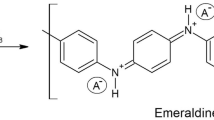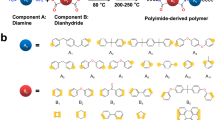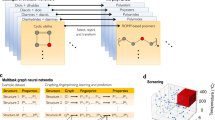Abstract
Poly(enaminonitrile)s (PEANs), a new class of thermally stable aromatic polymers, possess excellent thermal stability, good mechanical properties and are easily soluble in many organic solvents. Flexible, tough films can be cast from these solutions. These polymers undergo a ‘curing’ reaction at 300—350°C to insoluble, more dimensionally stable materials without evolution of volatile byproducts. We summarize here the dielectric data measured at a frequency of 100 kHz, 25°C for some PEANs, and discuss the results in relation to their structures.
Similar content being viewed by others
Log in or create a free account to read this content
Gain free access to this article, as well as selected content from this journal and more on nature.com
or
References
H. R. Kricheldorf, “Handbook of Polymer Synthesis,” Dekker, New York, N.Y., 1992.
C. Feger, M. M. Khojastec, and J. E. Mcgrath, “Polyimides: Materials, Chemistry and Characterization,” Elsevier, Amsterdam, 1989.
J. A. Moore and D. R. Robello, Macromolecules, 22, 1084 (1989).
C. C. Ku and R. Liepius, “Electrical Properties of Polymers: Chemical Principles,” Hanser, Munich, Vienna, New York, 1987.
A. R. Blythe, “Electrical Properties of Polymers,” Cambrige Univ. Press, Cambridge, 1979.
J. G. Kirkwood, J. Chem. Phys., 7, 911 (1939).
J. A. Moore and J.-H. Kim, Mater. Res. Soc. Symp. Proc., 227, 61 (1991).
J. A. Moore and S. Y. Kim, Polym. Prepr., Am. Chem. Soc., Div. Polym. Chem., 32, 403 (1991).
O. Exner, “Dipole Moment in Organic Chemistry,” Georg Thieme, Stuttgart, 1975.
J. G. Kirkwood and K. M. Fuoss, J. Chem. Phys., 9, 329 (1941).
D. W. Van Krevelen, “Properties of Polymers,” 3rd ed, Elsevier, Amsterdam, 1990.
Author information
Authors and Affiliations
Rights and permissions
About this article
Cite this article
Kim, JH., Kim, S., Moore, J. et al. Dielectric Properties of Poly(enaminonitrile)s. Polym J 32, 57–61 (2000). https://doi.org/10.1295/polymj.32.57
Issue date:
DOI: https://doi.org/10.1295/polymj.32.57



